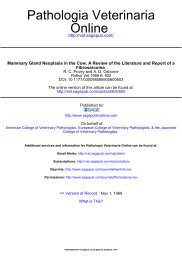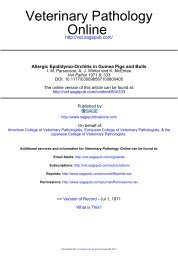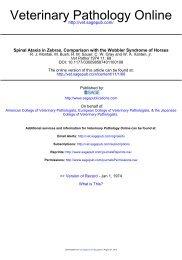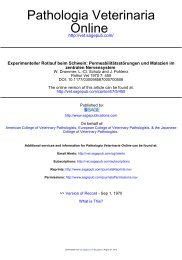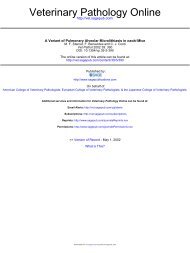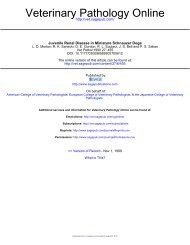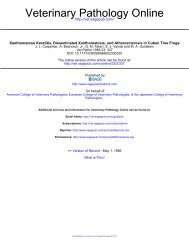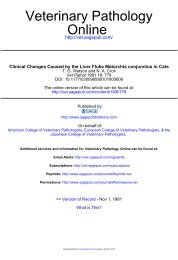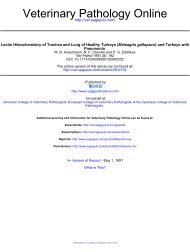Ceroid-Lipofuscinosis in a Cocker Spaniel Dog - Veterinary Pathology
Ceroid-Lipofuscinosis in a Cocker Spaniel Dog - Veterinary Pathology
Ceroid-Lipofuscinosis in a Cocker Spaniel Dog - Veterinary Pathology
You also want an ePaper? Increase the reach of your titles
YUMPU automatically turns print PDFs into web optimized ePapers that Google loves.
Veter<strong>in</strong>ary <strong>Pathology</strong> Onl<strong>in</strong>e<br />
http://vet.sagepub.com/<br />
<strong>Ceroid</strong>-<strong>Lipofusc<strong>in</strong>osis</strong> <strong>in</strong> a <strong>Cocker</strong> <strong>Spaniel</strong> <strong>Dog</strong><br />
L. M<strong>in</strong>atel, S. C. Underwood and J. C. Carfagn<strong>in</strong>i<br />
Vet Pathol 2000 37: 488<br />
DOI: 10.1354/vp.37-5-488<br />
The onl<strong>in</strong>e version of this article can be found at:<br />
http://vet.sagepub.com/content/37/5/488<br />
Published by:<br />
http://www.sagepublications.com<br />
On behalf of:<br />
American College of Veter<strong>in</strong>ary Pathologists, European College of Veter<strong>in</strong>ary Pathologists, & the Japanese College of Veter<strong>in</strong>ary<br />
Pathologists.<br />
Additional services and <strong>in</strong>formation for Veter<strong>in</strong>ary <strong>Pathology</strong> Onl<strong>in</strong>e can be found at:<br />
Email Alerts: http://vet.sagepub.com/cgi/alerts<br />
Subscriptions: http://vet.sagepub.com/subscriptions<br />
Repr<strong>in</strong>ts: http://www.sagepub.com/journalsRepr<strong>in</strong>ts.nav<br />
Permissions: http://www.sagepub.com/journalsPermissions.nav<br />
>> Version of Record - Sep 1, 2000<br />
What is This?<br />
Downloaded from vet.sagepub.com<br />
by guest on February 4, 2014
Vet Pathol 37:488–490 (2000)<br />
<strong>Ceroid</strong>-<strong>Lipofusc<strong>in</strong>osis</strong> <strong>in</strong> a <strong>Cocker</strong> <strong>Spaniel</strong> <strong>Dog</strong><br />
L. MINATEL, S.C.UNDERWOOD, AND J. C. CARFAGNINI<br />
Abstract. A neurodegenerative storage disease identified as ceroid-lipofusc<strong>in</strong>osis by light, fluorescence, and<br />
electron microscopic exam<strong>in</strong>ations was diagnosed <strong>in</strong> a 4-year-old female <strong>Cocker</strong> <strong>Spaniel</strong> dog with progressive<br />
ataxia and proprioceptive deficits. Stored pigment was found with<strong>in</strong> neurons of the bra<strong>in</strong> and sp<strong>in</strong>al cord and<br />
<strong>in</strong> smooth muscle cells of the ur<strong>in</strong>ary bladder and small muscular arteries. The microscopic f<strong>in</strong>d<strong>in</strong>gs resembled<br />
those found <strong>in</strong> six other cases of generalized ceroid-lipofusc<strong>in</strong>osis <strong>in</strong> this breed. However, the brown discoloration<br />
of the <strong>in</strong>test<strong>in</strong>es, which was the major gross lesion observed <strong>in</strong> those cases, was not found. This is the<br />
first report of the disease <strong>in</strong> Argent<strong>in</strong>a.<br />
Key words:<br />
microscopy.<br />
Brown bowel syndrome; ceroid-lipofusc<strong>in</strong>osis; <strong>Cocker</strong> <strong>Spaniel</strong> dogs; electron microscopy; light<br />
<strong>Ceroid</strong>-lipofusc<strong>in</strong>oses are a complex group of <strong>in</strong>herited<br />
neurodegenerative storage diseases that occur <strong>in</strong> humans and<br />
animals and are characterized by the progressive accumulation<br />
of a pigment similar to lipofusc<strong>in</strong> and ceroid with<strong>in</strong><br />
neurons and other cells of the body. In humans, there are<br />
four forms of the disease: <strong>in</strong>fantile, late <strong>in</strong>fantile, juvenile<br />
(Batten’s disease), and adult (Kuff’s disease). 8 A comparable<br />
spread was found <strong>in</strong> animals, especially <strong>in</strong> the dog. 8<br />
<strong>Ceroid</strong>-lipofusc<strong>in</strong>osis has been reported <strong>in</strong> several breeds<br />
of dogs, <strong>in</strong>clud<strong>in</strong>g English Setters, 4 Border Collies, 9 <strong>Cocker</strong><br />
<strong>Spaniel</strong>s, 2,5 Dachshunds, 10 Salukis, 1 and Chihuahuas. 7 Similar<br />
disease has been studied <strong>in</strong> Siamese cats, South Hampshire<br />
and Rambouillet sheep, Devon cattle, Nubian goats, and primates.<br />
8<br />
Although the stored pigment has similar sta<strong>in</strong><strong>in</strong>g and fluorescent<br />
properties similar to those of ceroid and lipofusc<strong>in</strong>,<br />
the major constituent of this pigment is a lipid-b<strong>in</strong>d<strong>in</strong>g prote<strong>in</strong><br />
that is a component (subunit c) of mitochondrial ATP<br />
synthase. 3 Studies on the ov<strong>in</strong>e, bov<strong>in</strong>e, can<strong>in</strong>e, and human<br />
(late <strong>in</strong>fantile and juvenile diseases) pigments have shown<br />
storage of subunit c. Patients with the <strong>in</strong>fantile form of ceroid-lipofusc<strong>in</strong>osis<br />
and M<strong>in</strong>iature Schnauzer dogs store a different<br />
prote<strong>in</strong>, identified as sph<strong>in</strong>golipid activator prote<strong>in</strong> (or<br />
sapos<strong>in</strong>s). 6 There are two families of ceroid-lipofusc<strong>in</strong>oses:<br />
Those characterized by storage of subunit c and those <strong>in</strong><br />
which sapos<strong>in</strong>s accumulate. 6 Here, we describe ceroid-lipofusc<strong>in</strong>osis<br />
<strong>in</strong> an adult <strong>Cocker</strong> <strong>Spaniel</strong> dog. This is the first<br />
reported case of ceroid-lipofusc<strong>in</strong>osis <strong>in</strong> Argent<strong>in</strong>a.<br />
A 4-year-old female <strong>Cocker</strong> <strong>Spaniel</strong> dog was presented to<br />
the referr<strong>in</strong>g veter<strong>in</strong>arian with progressive difficulty <strong>in</strong> walk<strong>in</strong>g.<br />
The cl<strong>in</strong>ical exam<strong>in</strong>ations showed no abnormalities except<br />
the gait. Neurologic exam<strong>in</strong>ations revealed hypermetric<br />
ataxia and proprioceptive deficits <strong>in</strong> all four limbs. The dog<br />
was euthanatized because of the progressive nature of the<br />
disease and the lack of response to treatments, and the body<br />
was submitted to the Department of <strong>Pathology</strong> at the Buenos<br />
Aires Faculty of Veter<strong>in</strong>ary Science for postmortem exam<strong>in</strong>ation.<br />
At necropsy, no significant gross abnormalities were<br />
found, except a mild cystitis. The bra<strong>in</strong> and sp<strong>in</strong>al cord and<br />
samples of ur<strong>in</strong>ary bladder were fixed <strong>in</strong> 10% formaldehyde<br />
neutral solution. Representative blocks were processed for<br />
paraff<strong>in</strong> embedment, sectioned at 5 m, and sta<strong>in</strong>ed with<br />
hematoxyl<strong>in</strong> and eos<strong>in</strong> (HE). The follow<strong>in</strong>g special sta<strong>in</strong>s<br />
were applied to paraff<strong>in</strong>-embedded sections: periodic acid–<br />
Schiff (PAS), Sudan black B, luxol fast blue, and thion<strong>in</strong>e.<br />
Unsta<strong>in</strong>ed frozen sections of the sp<strong>in</strong>al cord were exam<strong>in</strong>ed<br />
with fluorescence microscopy. Small formal<strong>in</strong>-fixed blocks<br />
from the sp<strong>in</strong>al cord were postfixed <strong>in</strong> 2% osmium tetroxide<br />
<strong>in</strong> phosphate buffer and processed for electron microscopic<br />
exam<strong>in</strong>ation.<br />
Microscopic exam<strong>in</strong>ation of slides sta<strong>in</strong>ed with HE revealed<br />
storage of yellow-brown granules <strong>in</strong> the cytoplasm of<br />
some neurons of the bra<strong>in</strong> and sp<strong>in</strong>al cord. The amount of<br />
stored pigment varied <strong>in</strong> different anatomic areas. Deposits<br />
were most pronounced <strong>in</strong> neurons of the sp<strong>in</strong>al cord (both<br />
dorsal and ventral horn) and basal bodies of the cerebellum<br />
(Fig. 1) but were less evident <strong>in</strong> neurons of the cerebral<br />
cortex and bra<strong>in</strong> stem and <strong>in</strong> Purk<strong>in</strong>je cells. The most affected<br />
neurons were swollen, and their nuclei and Nissl bodies<br />
were displaced to the periphery; others looked normal<br />
except for small amounts of stored material. The aggregations<br />
of granules were commonly at one pole of the neuronal<br />
body, often near the axon hillock (Fig. 2). Neuronal necrosis<br />
with astrocytosis and aggregation of gitter cells were found<br />
<strong>in</strong> basal bodies of the cerebellum and sp<strong>in</strong>al cord, but loss<br />
was not a common feature. The pigment was also evident <strong>in</strong><br />
the cytoplasm of glial cells. Similar but fewer yellow-brown<br />
granules were found <strong>in</strong> the cytoplasm of the smooth muscle<br />
cells of the ur<strong>in</strong>ary bladder (Fig. 3) and <strong>in</strong> the wall of small<br />
muscular arteries.<br />
The stored granules sta<strong>in</strong>ed magenta with PAS, black with<br />
Sudan black B, blue with luxol fast blue, and green with<br />
thion<strong>in</strong>e. Fluorescence microscopic exam<strong>in</strong>ation showed<br />
masses of yellow-green autofluorescent cytoplasmic granules.<br />
Electron microscopic exam<strong>in</strong>ation of affected neurons revealed<br />
a variable number of cytosomes conta<strong>in</strong><strong>in</strong>g some<br />
granular and amorphous but mostly membranous material<br />
(Fig. 4).<br />
The light microscopic f<strong>in</strong>d<strong>in</strong>gs, autofluorescence, and appearance<br />
of the <strong>in</strong>clusions on electron microscopy corre-<br />
488<br />
Downloaded from vet.sagepub.com by guest on February 4, 2014
Vet Pathol 37:5, 2000 Brief Communications and Case Reports<br />
489<br />
Fig. 1. Cerebellum; dog. Neurons of the basal bodies conta<strong>in</strong> stored pigment <strong>in</strong> the cytoplasm. Sudan black. Bar <br />
100 m.<br />
Fig. 2. Cerebellum; dog. Heavy aggregation of granular material at one pole of a neuron. Sudan black. Bar 16.5 m.<br />
Fig. 3. Ur<strong>in</strong>ary bladder; dog. Mild accumulation of granular material <strong>in</strong> the cytoplasm of smooth muscle cells (arrows).<br />
PAS, Mayer’s hematoxyl<strong>in</strong> countersta<strong>in</strong>. Bar 25 m.<br />
Fig. 4. Electron micrograph. Sp<strong>in</strong>al cord; dog. Lam<strong>in</strong>ated membranous material of neuronal cytosomes. Bar 0.2 m.<br />
spond closely with previous descriptions of ceroid-lipofusc<strong>in</strong>osis.<br />
Six cases of this disease have been reported <strong>in</strong> <strong>Cocker</strong><br />
<strong>Spaniel</strong> dogs. 2,5 All of them had the same feature: a generalized<br />
storage of a lipofusc<strong>in</strong>like pigment, with a heavy<br />
accumulation <strong>in</strong> smooth muscle. Moreover, all cases had the<br />
same gross lesion, yellow-brown discoloration of the <strong>in</strong>test<strong>in</strong>es.<br />
These characteristics def<strong>in</strong>ed a cl<strong>in</strong>ical entity <strong>in</strong> <strong>Cocker</strong><br />
<strong>Spaniel</strong> dogs named brown bowel syndrome. 2 In the present<br />
however, stored material was found with<strong>in</strong> smooth muscle<br />
cells of the ur<strong>in</strong>ary bladder and small muscular arteries, but<br />
the major gross lesion of this syndrome was not found. Intest<strong>in</strong>es<br />
of this dog were not available for pathologic study.<br />
There are three possible reasons for the lack of this characteristic<br />
gross lesion: 1) the amount of pigment stored <strong>in</strong><br />
smooth muscle cells of the <strong>in</strong>test<strong>in</strong>e was not enough to give<br />
the viscera a yellow-brown discoloration, 2) the severity of<br />
neurologic signs precipitated euthanasia before appreciable<br />
amounts of pigment could accumulate <strong>in</strong> smooth muscle<br />
cells, and 3) discoloration of the <strong>in</strong>test<strong>in</strong>es was so mild that<br />
the lesion was missed. The small amount of pigment found<br />
<strong>in</strong> smooth muscle cells of the ur<strong>in</strong>ary bladder support the<br />
first explanation.<br />
Bl<strong>in</strong>dness and behavioral changes were reported <strong>in</strong> <strong>Cocker</strong><br />
<strong>Spaniel</strong> dogs with ceroid-lipofusc<strong>in</strong>osis. 2,5 None of these<br />
signs were noticed <strong>in</strong> the present case.<br />
The microscopic f<strong>in</strong>d<strong>in</strong>gs <strong>in</strong> this dog are <strong>in</strong> accord with<br />
those found <strong>in</strong> the other six <strong>Cocker</strong> <strong>Spaniel</strong> dogs with generalized<br />
ceroid-lipofusc<strong>in</strong>osis. However, because brown<br />
bowel was not found, gross discoloration of the <strong>in</strong>test<strong>in</strong>es<br />
should not be expected <strong>in</strong> all cases.<br />
Acknowledgement<br />
We thank Dr. Daniel H. Farfall<strong>in</strong>i, Buenos Aires, Argent<strong>in</strong>a,<br />
for submitt<strong>in</strong>g the case.<br />
References<br />
1 Appleby EC, Longstaffe JA, Bell FR: <strong>Ceroid</strong>-lipofusc<strong>in</strong>osis<br />
<strong>in</strong> two Saluki dogs. J Comp Pathol 92:375–380,<br />
1982<br />
2 Jolly RD, Hartley WJ, Jones BR, Johnstone AC, Palmer<br />
Downloaded from vet.sagepub.com by guest on February 4, 2014
490 Brief Communications and Case Reports<br />
Vet Pathol 37:5, 2000<br />
AC, Blakemore WF: Generalized ceroid-lipofusc<strong>in</strong>osis<br />
and brown bowel syndrome <strong>in</strong> <strong>Cocker</strong> <strong>Spaniel</strong> dogs. NZ<br />
Vet J 42:236–239, 1994<br />
3 Jolly RD, Mart<strong>in</strong>us RD, Palmer DN: Sheep and other<br />
animals with ceroid-lipofusc<strong>in</strong>oses: their relevance to<br />
Batten disease. Am J Med Genet 42:609–614, 1992<br />
4 Koppang N: Neuronal ceroid-lipofusc<strong>in</strong>osis <strong>in</strong> English<br />
Setters. J Small Anim Pract 10:639–644, 1970<br />
5 Nimmo Wilkie JS, Hudson EB: Neuronal and generalized<br />
ceroid-lipofusc<strong>in</strong>osis <strong>in</strong> a <strong>Cocker</strong> <strong>Spaniel</strong>. Vet<br />
Pathol 19:623–628, 1982<br />
6 Palmer DN, Jolly RD, van Mil HC, Tyynela J, Westlake<br />
VJ: Different patterns of hydrophobic prote<strong>in</strong> storage <strong>in</strong><br />
different forms of neuronal ceroid-lipofusc<strong>in</strong>osis (NCL,<br />
Batten disease). Neuropediatrics 28:45–48, 1997<br />
7 Rac R, Giesecke PR: Lysosomal storage disease <strong>in</strong> Chihuahuas.<br />
Aust Vet J 51:403–404, 1975<br />
8 Summers BA, Cumm<strong>in</strong>gs JF, de Lahunta A: Veter<strong>in</strong>ary<br />
Neuropathology, pp. 233–236. Mosby, St. Louis, MO,<br />
1995<br />
9 Taylor RM, Farrow BRH: <strong>Ceroid</strong>-lipofusc<strong>in</strong>osis <strong>in</strong> Border<br />
Collie dogs. Acta Neuropathol 75:627–631, 1988<br />
10 Vandevelde M, Fatzer R: Neuronal ceroid-lipofusc<strong>in</strong>osis<br />
<strong>in</strong> older Dachshunds. Vet Pathol 17:686–692, 1980<br />
Request repr<strong>in</strong>ts from Dr. L. M<strong>in</strong>atel, Department of <strong>Pathology</strong>,<br />
Faculty of Veter<strong>in</strong>ary Science, University of Buenos<br />
Aires, Av. San Mart<strong>in</strong> 5285, (1417) Capital Federal (Argent<strong>in</strong>a).<br />
E-mail: lm<strong>in</strong>atel@ciudad.com.ar.<br />
Downloaded from vet.sagepub.com by guest on February 4, 2014



